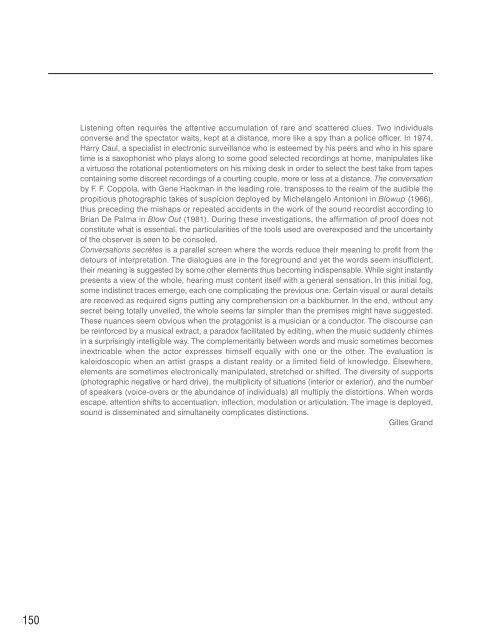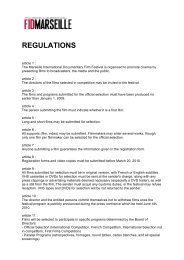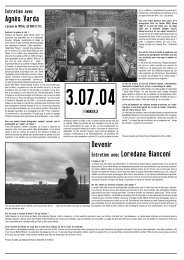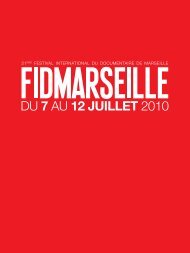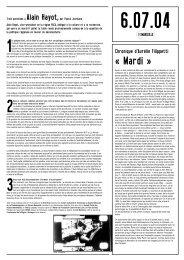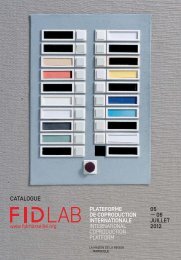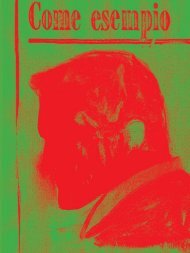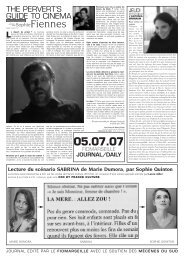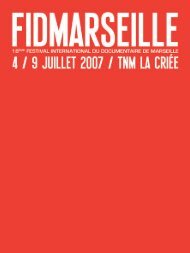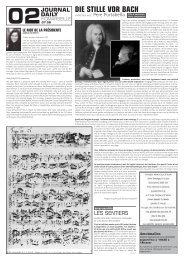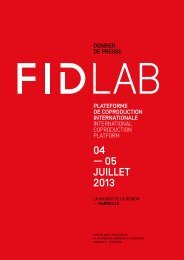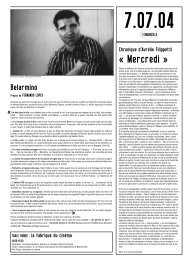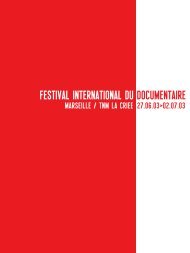FID Marseille 2011 - Festival international du documentaire de ...
FID Marseille 2011 - Festival international du documentaire de ...
FID Marseille 2011 - Festival international du documentaire de ...
Create successful ePaper yourself
Turn your PDF publications into a flip-book with our unique Google optimized e-Paper software.
150Listening often requires the attentive accumulation of rare and scattered clues. Two indivi<strong>du</strong>alsconverse and the spectator waits, kept at a distance, more like a spy than a police officer. In 1974,Harry Caul, a specialist in electronic surveillance who is esteemed by his peers and who in his sparetime is a saxophonist who plays along to some good selected recordings at home, manipulates likea virtuoso the rotational potentiometers on his mixing <strong>de</strong>sk in or<strong>de</strong>r to select the best take from tapescontaining some discreet recordings of a courting couple, more or less at a distance. The conversationby F. F. Coppola, with Gene Hackman in the leading role, transposes to the realm of the audible thepropitious photographic takes of suspicion <strong>de</strong>ployed by Michelangelo Antonioni in Blowup (1966),thus preceding the mishaps or repeated acci<strong>de</strong>nts in the work of the sound recordist according toBrian De Palma in Blow Out (1981). During these investigations, the affirmation of proof does notconstitute what is essential, the particularities of the tools used are overexposed and the uncertaintyof the observer is seen to be consoled.Conversations secrètes is a parallel screen where the words re<strong>du</strong>ce their meaning to profit from the<strong>de</strong>tours of interpretation. The dialogues are in the foreground and yet the words seem insufficient,their meaning is suggested by some other elements thus becoming indispensable. While sight instantlypresents a view of the whole, hearing must content itself with a general sensation. In this initial fog,some indistinct traces emerge, each one complicating the previous one. Certain visual or aural <strong>de</strong>tailsare received as required signs putting any comprehension on a backburner. In the end, without anysecret being totally unveiled, the whole seems far simpler than the premises might have suggested.These nuances seem obvious when the protagonist is a musician or a con<strong>du</strong>ctor. The discourse canbe reinforced by a musical extract, a paradox facilitated by editing, when the music sud<strong>de</strong>nly chimesin a surprisingly intelligible way. The complementarity between words and music sometimes becomesinextricable when the actor expresses himself equally with one or the other. The evaluation iskaleidoscopic when an artist grasps a distant reality or a limited field of knowledge. Elsewhere,elements are sometimes electronically manipulated, stretched or shifted. The diversity of supports(photographic negative or hard drive), the multiplicity of situations (interior or exterior), and the numberof speakers (voice-overs or the abundance of indivi<strong>du</strong>als) all multiply the distortions. When wordsescape, attention shifts to accentuation, inflection, mo<strong>du</strong>lation or articulation. The image is <strong>de</strong>ployed,sound is disseminated and simultaneity complicates distinctions.Gilles Grand


